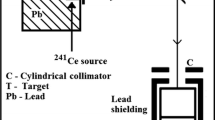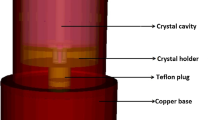Abstract
The total mass attenuation coefficients for natural beryl, corundum, garnet, pearl, and tourmaline gemstones were measured at 81, 356.5, 661.6, 1173.2, and 1332.5 keV photon energies. The samples were irradiated with 133Ba, 137Cs and 60Co radioactive point sources using gamma ray transmission method. Total atomic and electronic cross-sections, effective atomic numbers and electron densities were determined experimentally and theoretically. The experimental values were compared with the calculated values for all samples. The calculations were extended for total photon interactions in a wide energy range (1 keV–100 GeV) using WinXCom program of the most commonly irradiated gemstones with different sources of ionized radiation. The values of these parameters have been found to vary with photon energy and chemical composition of the gemstones. All variations of these parameters against energy are shown graphically for total photon interactions.




Similar content being viewed by others
References
Leal AS, Krambrock K, Ribeiro LGM, Menezes MÂBC, Vermaercke P, Sneyers L (2007) Study of neutron irradiation-induced colors in Brazilian topaz. Nucl Instrum Methods Phys Res A 580:423–426
Olabanji SO, Ige OA, Mazzoli C, Ceccato D, Akintunde JA, De Poli M, Moschini G (2005) Accelerator-based analytical technique in the evaluation of some Nigeria’s natural minerals: fluorite, tourmaline and topaz. Nucl Instrum Methods Phys Res B 240:350–355
Nassau K (2003) The physics and chemistry of color, 2nd edn. Wiley–Interscience, New York
Yukihara EG, Yoshimura EM, Okuno E (2002) Paramagnetic radiation-induced defects in gamma-irradiated natural topazes. Nucl Instrum Methods Phys Res B 191:266–270
Nassau K (1984) Gemstone enhancement: heat, irradiation, impregnation, dyeing, and other treatments which alter the appearance of gemstones, and the detection of such treatments, 1st edn. Butterworth-Heinemann, London
Ashbuugh CE (1988) Gemstone irradiation and radioactivity. Gems & Gemology 24(4):196–213
Berger MJ, Hubbel JH (1987) XCOM: photon cross sections on a personal computer. NBSIR 87:3597–3598
Gerward L, Guilbert N, Jensen KB, Levring H (2004) WinXCom-a program for calculating X-ray attenuation coefficients. Radiat Phys Chem 71:653–654
Hine GJ (1952) The effective atomic numbers of materials for various gamma ray interactions. Phys Rev 85:725
Han I, Aygun M, Demir L, Sahin Y (2012) Determination of effective atomic numbers for 3d transition metal alloys with a new semi-empirical approach. Ann Nucl Energy 39:56–61
Medhat ME (2012) Application of gamma-ray transmission method for study the properties of cultivated soil. Ann Nucl Energy 40:53–59
Mostofinejad D, Reisi M, Shirani A (2012) Mix design effective parameters on γ-ray attenuation coefficient and strength of normal and heavyweight concrete. Constr Build Mater 28:224–229
Kurudirek M (2011) Estimation of effective atomic numbers of some solutions for photon energy absorption in the energy region 0.2–1.5 MeV: an alternative method. Nucl Instrum Methods Phys Res A. 659:302–306
Medhat ME (2011) Studies on effective atomic numbers and electron densities in different solid state track detectors in the energy range 1 keV–100 GeV. Ann Nucl Energy 38:1252–1263
Un A, Sahin Y (2011) Determination of mass attenuation coefficients, effective atomic and electron numbers, mean free paths and kermas for PbO, barite and some boron ores. Nucl Instrum Methods Phys Res B 269:1506–1511
Demir F (2010) Determination of mass attenuation coefficients of some boron ores at 59.54 keV by using scintillation detector. Appl Radiat Isot 68:175–179
Baştuğ A, Gürol A, Içelli O, Şahin Y (2010) Effective atomic numbers of some composite mixtures including borax. Ann Nucl Energy 37:927–933
Kaewkhao J, Limsuwan P (2010) Mass attenuation coefficients and effective atomic numbers in phosphate glass containing Bi2O3, PbO and BaO at 662 keV. Nucl Instrum Methods Phys Res A 619:295–297
Kaewkhao J, Lofimkitjaroenporn P, Tuscharoen S, Kittiauchawal T, Chewpraditkul W, Limsuwan P (2012) Measurement of mass attenuation coefficients of blue sapphire at different photon energy by compton scattering technique. Appl Mech Mater 103:71–75
Limkitjaroenporn P, Kaewkhao J, Limsuwan P, Chewpraditkul W (2011) Physical, optical, structural and gamma-ray shielding properties of lead sodium borate glasses. J Phys Chem Solids 72:245–251
Author information
Authors and Affiliations
Corresponding author
Rights and permissions
About this article
Cite this article
Medhat, M.E. Study of the mass attenuation coefficients and effective atomic numbers in some gemstones. J Radioanal Nucl Chem 293, 555–564 (2012). https://doi.org/10.1007/s10967-012-1794-y
Received:
Published:
Issue Date:
DOI: https://doi.org/10.1007/s10967-012-1794-y




